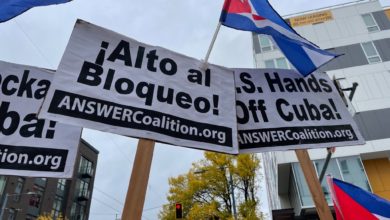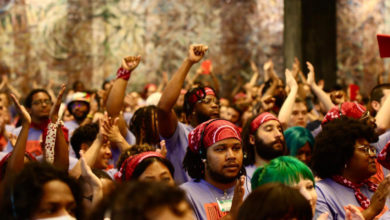Hurricane Katrina showed the world many things. One was the clear difference between how health care is treated in the United States compared to socialist Cuba.
On Sept. 19, Cuban President Fidel Castro Ruíz announced the formation of the Henry Reeves International Contingent of Doctors Specializing in Disaster Situations and Serious Epidemics. He made the announcement during a graduation ceremony of medical workers.

The contingent is named after a U.S.-born supporter of Cuba’s first war of independence against Spain. It arose from Cuba’s offer on Sept. 1 to send almost 1,600 medical doctors to the Gulf Coast of the United States to help the victims of Hurricane Katrina amidst U.S. government neglect.
In spite of the enormous needs of the people of the Gulf Coast region, U.S. authorities rebuffed the Cuban offer of assistance.
An unprecedented number of storms of greater-than-normal intensity are predicted for the 2005 hurricane season. Revolutionary Cuba has taken steps to form a medical response team to prepare for aiding those who may suffer from the consequences of the hurricanes.
The Henry Reeves contingent is an international brigade intended to respond anywhere that natural or other disasters occur. The taskforce is being expanded from the original 1,586 physicians offered for the Gulf Coast to include 200 physicians who graduated in 2003 to 2004, 600 students in their sixth year of training and 800 in their fifth year of training.
In contrast to Cuba’s response to the dire predictions for the hurricane season, the U.S. government is using the catastrophe in Louisiana, Alabama and Mississippi to attack the living standards of workers, employed and unemployed. At a time when there is a need for a massive increase in spending, Bush has called for cutting already existing social services to pay for the rebuilding of the Gulf Coast region.
In an Oct. 4 press conference, Bush said, “Congress needs to pay for as much of the hurricane relief as possible by cutting spending. … I call on members to make real cuts in non-security spending.” In other words, Pentagon spending would not be touched. And Bush ruled out rescinding or reducing the huge tax giveaways to the rich that his government instituted in the past few years.
Bush also made it clear that the federal government would not be responsible for the reconstruction of the region. “The engine that drives growth and job creation in America is the private sector, and the private sector will be the engine that drives the recovery of the Gulf Coast,” he said.
In the capitalist United States, the interests of private property and profit are the government’s main concern. Bush’s description of the private sector as “the engine that drives the recovery” is but one example of this concern for profits over people’s needs.
Different social systems
The stark difference between the Cuban and U.S. government responses to Katrina is a result of the fact that the respective governments represent different class interests. The Cuban government is a socialist government that operates in the interests of the Cuban working class—the vast majority of the Cuban people. The actions of the Cuban government are based on improving the living standards of the Cuban people.
The U.S. government is a capitalist government that operates in the interests of a tiny minority of bankers and corporate owners. The actions of the U.S. government are based on maximizing profits for the bankers and corporate owners at the expense of the vast majority of working and poor people.
The fundamental differences in the two social systems can be seen in their respective medical systems. In 2004, Cuba’s gross domestic product was just over $31 billion. With a population 26 times the size of Cuba, the U.S. GDP was just shy of $11 trillion—about 350 times that of Cuba. In spite of a much smaller economy, Cuba has twice as many physicians per capita as the United States. (Harpers.org)
Unlike the 46 million uninsured people in the United States, there are no uninsured people in Cuba because there is no parasitic insurance structure. Health care in Cuba is universal and free for all Cubans.
The infant mortality rate is an internationally recognized marker of a country’s well-being. It is defined as the number of infant deaths in the first year of life per 1,000 births. The most economically developed countries have rates that are less than 10 per 1,000.
On top of its efforts to develop its economy, Cuba has to combat a 46-year- old U.S. economic blockade that prohibits the sale of medical technology. Despite these obstacles, Cuba’s infant mortality rate in 2005 was an astounding 5.8 per 1,000 live births—compared to 6.5 per 1,000 in the United States.
Since 1988, the cost of insurance in the United States has increased an average of 11 percent each year, generating tremendous profits for the billionaire owners of insurance companies. Co-payments for medical services and drugs have risen steadily along with the cost of insurance. For most workers who have access to this insurance, at least some of these costs come out of their paychecks.
In contrast, the wages of 857,000 health and education workers in Cuba were raised this July.
The Cuban healthcare system is based on the “community doctor” model. Begun in 1984 as a pilot project, it is now the foundation of Cuba’s healthcare system. A physician-nurse pair, or Basic Health Team, works together in a neighborhood of 700 to 800 people to provide comprehensive medical attention and regular health assessments.
As part of this model, the BHT relies on the Basic Work Group, made up of an internist, pediatrician, gynecologist, psychologist, biostatistician, nursing coordinator and social worker. The Work Group functions as a community-based referral unit for support, supervisory and assessment functions.
As part of the normal care delivery, medical and nursing care is provided either in the neighborhood clinic or in the person’s home. Patients can request that their family doctor or nurse come with them for lab tests or when hospitalized. It is a regular practice for the family medical worker to call on the home of a person who missed a scheduled visit to the clinic.
In a comprehensive speech on July 26, President Castro reviewed a program of infrastructure improvements to the healthcare sector. Beginning in 2004, 50 hospitals were renovated, expanded and equipped with new services at an estimated cost of $835 million.
Medical solidarity
Cuba’s offer of solidarity to Hurricane Katrina’s victims is part of a history of extending concrete material aid without political conditions to the world’s people. As of August 2005, there were 24,950 Cuban health workers working in 68 countries, including more than 12,000 doctors in Venezuela.
One of the more remarkable efforts to improve access to health care around the world is the Latin American Medical School (ELAM). In the aftermath of the destruction caused by Hurricanes George and Mitch in Central America, Cuba sent 1,000 doctors to volunteer in the disaster zones.
Realizing the extent to which the affected areas lacked any healthcare services, the Cuban government made two decisions. One was to extend the assistance of the Cuban volunteers. The other was to establish the ELAM. The school offered 10,000 full scholarships to students from medically underserved areas.
As part of their training, ELAM students are urged to return to practice medicine in their communities to directly address the absence of care. In August, the first class of medical students from 20 countries graduated after completing six years of medical school.
Observing ELAM’s potential to alleviate the legacy of imperialist exploitation, the Venezuelan government is mirroring Cuba’s example. As part of the Bolivarian revolutionary process, 22,043 medical students are being trained by Cuban and Venezuelan doctors with the goal of returning to their communities.
Cuba and Venezuela are collaborating to expand the example of ELAM to train an additional 20,000 Venezuelan doctors and 30,000 doctors from Latin America and the Caribbean. Like ELAM, these programs offer full scholarships.
The typical cost of medical school in the United States is over $300,000. At that rate, the Cuban-Venezuelan project of providing scholarships for 50,000 students would be a $15 billion act of solidarity with the people of Latin America.
The Cuban example of providing free and comprehensive health care as a human right, not as a commodity for profit, shows what is possible when a country’s priorities and resources are used to meet human needs.
Imagine the world if the $445 billion reserved for the Pentagon’s annual budget was used to provide health care instead of warfare.
Cuban doctors, ready to assist the victims of Hurricane Katrina, wait to hear from the U.S. government, Havana, Sept. 4.
Photo: Claudia Daut




